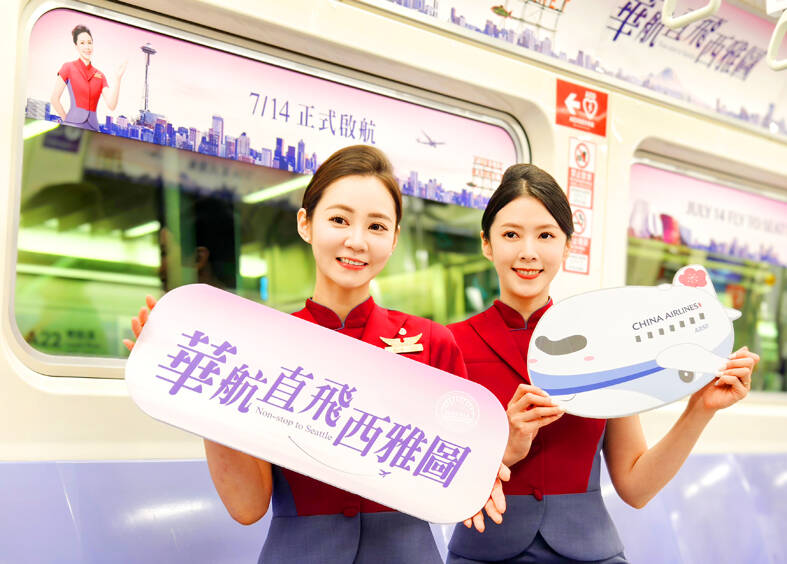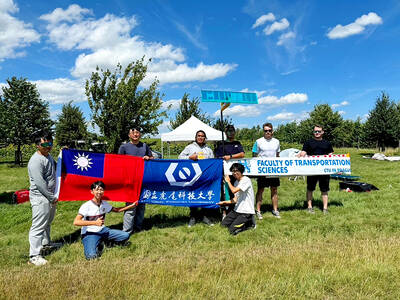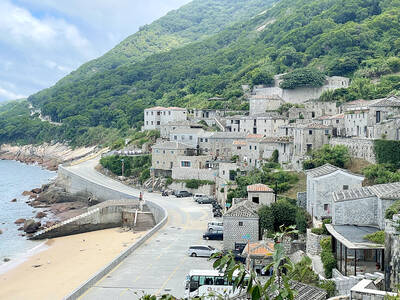An increase in flights to Seattle this year is expected to increase the number of US-bound tourists from Taiwan to about 393,000, or 78.6 percent of the number recorded in 2019, statistics from the US National Travel and Tourism Office (NTTO) showed.
Four airlines now operate flights from Taiwan to Seattle and the number of flights has doubled from last year.
Of those airlines, China Airlines operates 119 flights to the west coast of the US after the addition of a Taipei-Seattle route that was launched yesterday.

Photo:Yao Chieh-hsiu, Taipei Times
Seattle is the northernmost destination for flights from Taiwan to the western US. EVA Air was the first to launch flights between Taipei and Seattle in 1993, while China Airlines previously operated flights to and from Seattle from 2004 to 2008.
US carrier Delta Air Lines on Sunday last week launched a Taipei-Seattle route, with flights offered seven times per week between the cities.
Meanwhile, EVA Air on June 25 increased flights on its Seattle route to 10 times per week, and StarLux Airlines is expected to launch flights to and from the US city on Aug. 16, starting with three flights per week.
The addition of the StarLux flights would bring the total number of flights between Taipei and Seattle up to 25 per week, and passengers would have at least three flights per day to choose from.
Other US west-coast destinations from Taiwan include Los Angeles (with some flights to Ontario International Airport), San Francisco and Seattle. There are also flights to and from Chicago, Houston and New York.
The passenger load factor on flights to and from the US was more than 90 percent last year, Civil Aviation Administration data showed.
Booking records from China Airlines, EVA Air and StarLux show that many flights to the US are fully booked during the summer vacation, and business class is more popular than economy class on most of those flights.
The total number of foreign tourists to the US this year is expected to reach 77.7 million, a year-on-year increase of 10.4 million, NTTO Taiwan representative Luo Shih-wen (羅世玟) said yesterday.
The figure is forecast to reach 85.2 million next year, Luo added.
Of those visiting the US this year, about 393,000 would be from Taiwan, compared with 499,520 in 2019 before the COVID-19 pandemic slowed global travel, she said.
China Airlines said it is optimistic that travel demand for US destinations is growing in Taiwan, and direct flights to Seattle are an important step toward it expanding its North American network.
“The total number of passengers at Seattle-Tacoma International Airport last year exceeded 50 million, making it the largest airport in the northwest region of the US,” the airline said in a statement.
“China Airlines has planted its flag in Seattle with the launch of direct flights,” it said.
Separately, the Ministry of Transportation and Communications’ Institute of Transportation said that more work is needed to promote Taiwan Taoyuan International Airport as a hub for people traveling between the US and other destinations in Asia.
An increase in the frequency of flights between Taiwan and major US cities could facilitate that, the institute said.
For example, Washington and Boston have the greatest potential as destinations that could spur use of Taoyuan airport as a key hub, it said, adding that about 200,000 passengers travel annually between Taiwan and those cities
Atlanta has nearly 180,000 passengers from Taiwan, Newark has about 150,000 and Dallas about 140,000, the institute said.
China Airlines and EVA Air have both said that they would evaluate new destinations in the US market based on the delivery schedule of new aircraft.
StarLux Airlines, which flies only to San Francisco and Los Angeles in the US, said it also plans to expand to cities in eastern and central US.

The Chinese military has built landing bridge ships designed to expand its amphibious options for a potential assault on Taiwan, but their combat effectiveness is limited due to their high vulnerability, a defense expert said in an analysis published on Monday. Shen Ming-shih (沈明室), a research fellow at the Institute for National Defense and Security Research, said that the deployment of such vessels as part of the Chinese People’s Liberation Army (PLA) Navy’s East Sea Fleet signals a strong focus on Taiwan. However, the ships are highly vulnerable to precision strikes, which means they could be destroyed before they achieve their intended

The Taiwan Experience Education Program (TEEP) has funded short-term internships in Taiwan for more than 4,500 young people from more than 40 countries since 2015, with the goal of attracting and retaining international talent, the Ministry of Education said yesterday. Fifty-five colleges launched 514 projects this year, including in fields such as semiconductors, artificial intelligence, medicine and biotechnology, green energy, and sustainability, it said. The program provides research and practical internships in Taiwan for two to six months, and offers cultural exchange and networking opportunities, the ministry said. For example, National Formosa University’s Embedded System and Autopilot Laboratory developed two solar-powered drones in

GLOBAL: Although Matsu has limited capacity for large numbers of domestic tourists, it would be a great high-end destination for international travelers, an official said Lienchiang County’s (Matsu) unique landscape and Cold War history give it great potential to be marketed as a destination for international travelers, Tourism Administration Director General Chen Yu-hsiu (陳玉秀) said at the weekend. Tourism officials traveled to the outlying island for the Matsu Biennial, an art festival that started on Friday to celebrate Matsu’s culture, history and landscape. Travelers to Matsu, which lies about 190km northwest of Taipei, must fly or take the state-run New Taima passenger ship. However, flights are often canceled during fog season from April to June. Chen spoke about her vision to promote Matsu as a tourist attraction in

Taipei resident Mu Chu-hua caught some glimpses of China’s mighty military parade on YouTube on Wednesday. As she watched hypersonic missiles roll down Beijing’s Changan Avenue and troops march in lockstep, she did not feel like they posed a threat to Taiwan. Mu, a 69-year-old retiree, said she saw the parade as simply a way for Chinese President Xi Jinping (習近平) to “say thank you to the troops.” “I thought it was quite normal,” she said. “It was very cool.” China’s military parade commemorating the end of World War II was being watched internationally for insights into Beijing’s military advances and its show